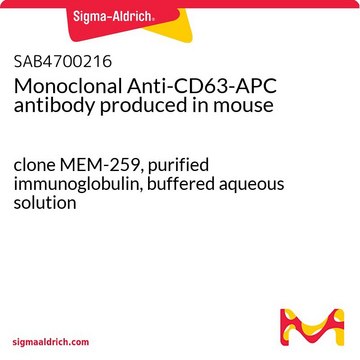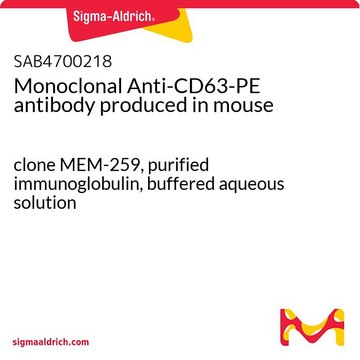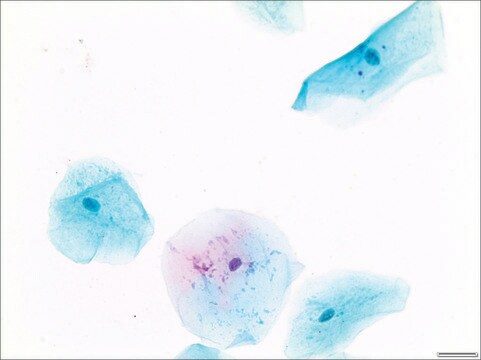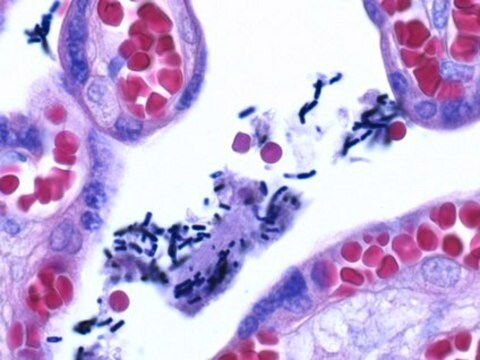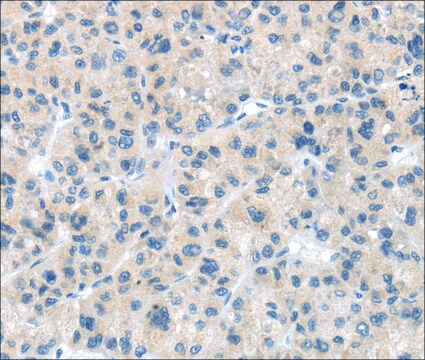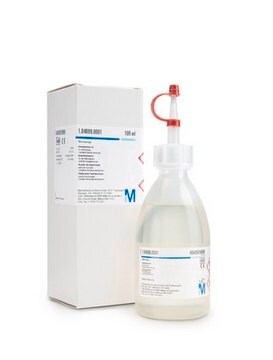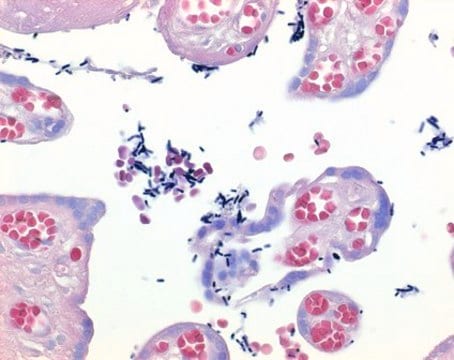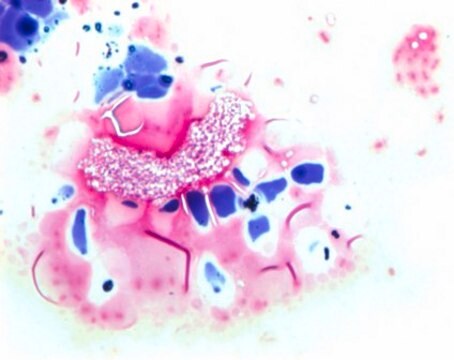SAB4700217
Monoclonal Anti-CD63-FITC antibody produced in mouse
clone MEM-259, purified immunoglobulin, buffered aqueous solution
Se connecterpour consulter vos tarifs contractuels et ceux de votre entreprise/organisme
About This Item
Code UNSPSC :
12352203
Nomenclature NACRES :
NA.43
Produits recommandés
Source biologique
mouse
Niveau de qualité
Conjugué
FITC conjugate
Forme d'anticorps
purified immunoglobulin
Type de produit anticorps
primary antibodies
Clone
MEM-259, monoclonal
Forme
buffered aqueous solution
Espèces réactives
human
Technique(s)
flow cytometry: suitable
Isotype
IgG1
Numéro d'accès NCBI
Numéro d'accès UniProt
Conditions d'expédition
wet ice
Température de stockage
2-8°C
Modification post-traductionnelle de la cible
unmodified
Informations sur le gène
human ... CD63(967)
Description générale
CD63 belongs to the transmembrane 4 superfamily (TM4SF). CD63 is an integral membrane glycoprotein expressed in late endosomes and lysosomes, and is also present in the platelet dense granule membrane.
Immunogène
HPB-ALL T cell line
Application
The reagent is designed for Flow Cytometry analysis of human blood cells using 20 μL reagent / 100 μL of whole blood or 1e6 cells in a suspension. The content of a vial (2 mL) is sufficient for 100 tests.
Actions biochimiques/physiologiques
CD63 is one of the platelet activation marker, which plays a vital role in platelet aggregation, adhesion to collagen, uptake of oxidized low-density lipoprotein (LDL) in vitro and regulation of angiogenesis. Improved metabolic control deduce platelet activation marker in the type-2 diabetes patients and helps in reducing development of diabetic late complications. Inadequate expression of CD63 results in the autosomal recessive inherited disorder, Hermansky-Pudlak syndrome. CD63 is associated with various cellular functions such as cellular adhesion, cell differentiation, migration, carcinogenesis, and tumor progression. CD63 is highly expressed in initial stage of Merkel cell carcinoma and decreased in later stages; therefore, CD63 is considered to be a potential prognostic factor for this malignancy.
Caractéristiques et avantages
Evaluate our antibodies with complete peace of mind. If the antibody does not perform in your application, we will issue a full credit or replacement antibody. Learn more.
Forme physique
Solution in phosphate buffered saline containing 15 mM sodium azide and 0.2% high-grade protease free BSA as a stabilizing agent.
Clause de non-responsabilité
Unless otherwise stated in our catalog or other company documentation accompanying the product(s), our products are intended for research use only and are not to be used for any other purpose, which includes but is not limited to, unauthorized commercial uses, in vitro diagnostic uses, ex vivo or in vivo therapeutic uses or any type of consumption or application to humans or animals.
Vous ne trouvez pas le bon produit ?
Essayez notre Outil de sélection de produits.
Code de la classe de stockage
10 - Combustible liquids
Classe de danger pour l'eau (WGK)
WGK 2
Point d'éclair (°F)
Not applicable
Point d'éclair (°C)
Not applicable
Faites votre choix parmi les versions les plus récentes :
Déjà en possession de ce produit ?
Retrouvez la documentation relative aux produits que vous avez récemment achetés dans la Bibliothèque de documents.
Improved metabolic control decreases platelet activation markers in patients with type-2 diabetes.
Eibl N, et al.
European Journal of Clinical Investigation, 34(3), 205-209 (2004)
A novel link between integrins, transmembrane-4 superfamily proteins (CD63 and CD81), and phosphatidylinositol 4-kinase.
Berditchevski F, et al.
The Journal of Biological Chemistry, 272(5), 2595-2598 (1997)
The protein CD63 is in platelet dense granules, is deficient in a patient with Hermansky-Pudlak syndrome, and appears identical to granulophysin.
Nishibori M, et al.
The Journal of Clinical Investigation, 91(4), 1775-1782 (1993)
Expression of the tetraspanins CD9, CD37, CD63, and CD151 in Merkel cell carcinoma: strong evidence for a posttranscriptional fine-tuning of CD9 gene expression.
Woegerbauer M, et al.
Modern Pathology, 23(5), 751-762 (2010)
The small chemical vacuolin-1 inhibits Ca(2+)-dependent lysosomal exocytosis but not cell resealing.
Jan Cerny et al.
EMBO reports, 5(9), 883-888 (2004-08-28)
Resealing after wounding, the process of repair following plasma membrane damage, requires exocytosis. Vacuolins are molecules that induce rapid formation of large, swollen structures derived from endosomes and lysosomes by homotypic fusion combined with uncontrolled fusion of the inner and
Notre équipe de scientifiques dispose d'une expérience dans tous les secteurs de la recherche, notamment en sciences de la vie, science des matériaux, synthèse chimique, chromatographie, analyse et dans de nombreux autres domaines..
Contacter notre Service technique